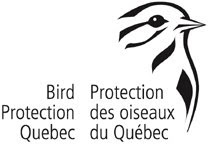St-Lazare: A few shorebirds are starting to appear at St-Lazare sand pits. Today 3 Dunlin (3 Bécasseau variable) joined the small flock of Least Sandpipers (Bécasseaux minuscules) along with single Semipalmated Sandpiper and Plover, Killdeer and both yellowlegs (Bécasseau semipalmé et le pluvier, pluvier kildir et les deux chevaliers). Il y avait aussi une Grande Aigrette. There was also a Great Egret (Grande Aigrettet) here making it 123 species for the site so far this year.
For those interested there has been a singing Field Sparrow (Bruant des champs) present for a few days, quite unusual for the site. To see it park at the end of Lotbiniere by the no parking sign on the steel fence. Go through where it says no unauthorised access and the bird is in the willows by the yellow barrier, the whip-poor-wills and Vesper Sparrows (engoulevent bois-pourri et Bruant vespéral) are in the same area. - Mark Dennis
-------------------------------------------------------------
Île-Bizard: This morning, Jacques Lacroix and I birded the Parc-Nature at Île-Bizard this morning. The weather was great as were the birds. We were fortunate to have a Least Bittern (Petit Blongios) pop out of the reeds giving us quick but good views. Also, there were 7+ Virginia Rails, several of them easily seen, 7 Green Herons, 4 Great Blue Herons (7 hérons verts, 4 Grands Hérons) as well as many Swamp Sparrows and Marsh Wrens (Bruant des marais et troglodyte des marais) some of which were nest building.
We also watched a Merlin (faucon émerillon) rocket across the 2nd marsh area in pursuit--unsuccessfully--in pursuit of a Tree Swallow (hirondelle bicolore). Other raptors included a Cooper's Hawk, a Red-shouldered Hawk and a Turkey Vulture (Épervier de Cooper, un Buse à épaulettes et un Urubu à tête rouge) plus the two Barred Owls (Chouettes rayée) described below.
We had only 6 warbler species including Northern Waterthrush, Tennessee and Northern Parula. 6 espèces de parulines dont la Paruline des ruisseaux, le Tennessee et Paruline à collier
The highlight, however, might have been hearing two Barred Owls, an adult calling and a juvenile doing its begging call. We were then able to watch the adult feeding the juvenile as well as show several other people in the area the owls. - Charlie Nims
Wednesday, May 16, 2012
Subscribe to:
Post Comments (Atom)





No comments:
Post a Comment